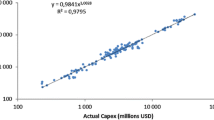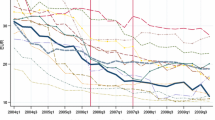Abstract
The welfare effects of mergers in the mobile industry is the topic of an ongoing debate, however, there is still a lack of empirical evidence about the effect on consumer surplus. In this paper, we provide a simple structural model that accounts for investment in order to investigate the effect of mergers on consumer surplus in the mobile industry. Using a Cournot model with investment in cost-reducing technologies, and data on mobile Internet traffic from 18 European markets, we find that consumer surplus is maximized in markets with 3 symmetric operators. This finding accords well with a rising price per user and investment as a result of a merger. It suggests that, in mobile mergers, except 3-2 merger, dynamic efficiencies from investment outweigh static efficiencies from market power.


Similar content being viewed by others
Notes
See Bertschek et al. (2015) for a review of the literature. Roller and Waverman (2001) and Czernich et al. (2011) who find significant positive effects of telecommunications infrastructure on Gross Domestic Product, and Bertschek and Niebel (2016) who find that mobile internet usage by employees does cause higher labour productivity.
See the EU Commission decisions on these mergers: M7018, M6992 and M7612.
The Austrian regulator and the competition authority conducted an ex-post evaluation of the merger between H3G and Orange in 2013 and find an increase in price per user in the long run (RTR 2016). In a report commissioned by the European Commission, Aguzzoni et al. (2015) conduct an ex-post evaluation of the approved mergers in Austria (2006) and The Netherlands (2007) and find mixed results. The Austrian merger did not affect price, whereas the merger in The Netherlands tend to be associated to a price increase.
Gagnepain and Pereira (2007) show that consumer surplus increases with entry into the Portuguese mobile market. However, their analysis focuses on the years 1992–2003, a period when investment was focused on voice and not, as is currently the case, on mobile Internet.
This functional form can be derived from a framework where variation in the stock of knowledge is proportional to development effort (\(dA=Ad\mu\)), and that development effort is a concave function of investment (\(\mu (z)=\beta ' \ln z\)). It can be shown that the constant marginal cost writes: \(c(z)=\frac{C_0}{A(z)}=\frac{C_0}{A_0}z^{-\beta '}\). Where \(C_0\) is the initial cost of production and \(A_0\) is the initial stock of knowledge. \(\alpha ' \equiv \frac{C_0}{A_0}\).
See Dasgupta and Stiglitz (1980).
Note that Eq. (8) holds as long as the elasticity of demand is greater than 0.5, that is \(\beta \ge 0.5\). Under this condition, \(1-\frac{1}{\beta N} \ge 0\).
The tricube weighting function is defined as follows:
$$\begin{aligned} K(u)= \frac{70}{81} \left( 1- u^3\right) ^3 . \end{aligned}$$(14)For all u such that \(|u| \le 1, u=l-k\).
References
Aguzzoni, L., Buehler, B., Di Martile, L., Ecker, G., Kemp, R., Schwarz, A., & Stil, R. (2015). Ex-post analysis of two mobile telecom mergers: T-Mobile/tele.ring in Austria and T-Mobile/Orange in the Netherlands. Report. European Commission.
Bertschek, I., & Niebel, T. (2016). Mobile and more productive? Firm-level evidence on the productivity effects of mobile internet use. Telecommunications Policy, 40(9), 888–898.
Bertschek, I., Briglauer, W., Huschelrath, K., Kauf, B., & Niebel, T. (2015). The economic impacts of broadband internet: A survey. Review of Network Economics, 14(4), 201–227.
Cleveland, W. S. (1979). Robust locally weighted regression and smoothing scatterplots. Journal of the American Statistical Association, 74, 829–836.
Czernich, N., Falck, O., Kretschmer, T., & Woessmann, L. (2011). Broadband infrastructure and economic growth. The Economic Journal, 121, 505–532.
Dasgupta, P., & Stiglitz, J. (1980). Industrial structure and the nature of innovative activity. The Economic Journal, 90, 266–293.
Eurobarometer. (2014). E-Communications household survey number 414. Report. European Commission.
Frisch, W., & Waugh, F. V. (1933). Partial time regressions as compared with individual trends. Econometrica, 1, 387–401.
Gagnepain, P., & Pereira, P. (2007). Entry, costs reduction, and competition in the Portuguese mobile telephony industry. International Journal of Industrial Organization, 25, 461–481.
Genakos, C., & Valletti, T. (2011). Testing the ”waterbed” effect in mobile telephony. Journal of the European Economic Association, 9, 1114–1142.
Genakos, C., Valletti, T., & Verboven, F. (2018). Evaluating market consolidation in mobile communications. Economic Policy, 33(93), 45–100.
Grajek, M., Gugler, K. P., Kretschmer, T., & Miscisin, I. (2017). Static or dynamic efficiency: Horizontal merger effects in the wireless telecommunications industry. Review of Industrial Organization (forthcoming).
Hazlett, T. W., Oh, S., & Skorup, B. (2014). Natural experiments in mobile phone regulation: Estimated effects of prohibiting handset bundling in Finland and Belgium. George Mason Law & Economics Research Paper No 14–17. George Mason University.
Houngbonon, G. V., & Jeanjean, F. (2016). What level of competition intensity maximises investment in the wireless industry? Telecommunications Policy, 40(8), 774–790.
Jeanjean, F., & Houngbonon, G. V. (2017). Market structure and investment in the mobile industry. Information Economics and Policy, 38, 12–22.
Kim, J., Kim, Y., Gaston, N., Lestage, R., Kim, Y., & Flacher, D. (2011). Access regulation and infrastructure investment in the mobile telecommunications industry. Telecommunications Policy, 35, 907–919.
Koh, H., & Magee, C. L. (2006). A functional approach for studying technological progress: Application to information technology. Technological Forecasting & Social Change, 73, 1061–1083.
Koh, H., & Magee, C. L. (2008). A functional approach for studying technological progress: Extension to energy technology. Technological Forecasting & Social Change, 75, 735–758.
Lambrecht, A., Seim, K., & Skiera, B. (2007). Does uncertainty matter? Consumer behavior under three-part tariffs. Marketing Science, 26, 698–710.
Roller, L.-H., & Waverman, L. (2001). Telecommunications infrastructure and economic development: A simultaneous approach. American Economic Review, 91, 909–923.
RTR. (2016). Ex-post analysis of the merger between H3G Austria and Orange Austria. Report. Rundfunk & Telekom Regulierungs—GmbH.
Schmutzler, A. (2013). Competition and investment—A unified approach. International Journal of Industrial Organization, 31, 477–487.
Vives, X. (2008). Innovation and competitive pressure. The Journal of Industrial Economics, 56, 419–469.
Whalley, J., & Curwen, P. (2014). From global aspirations to regional dominance: The case of Deutsche Telekom. Info, 16, 33–53.
Acknowledgements
A previous version of this paper was presented at the 27th European Regional Conference of the International Telecommunications Society in Cambridge (UK) in September 2016 and the International Industrial Organization Conference in Boston (US) April 2017. The authors are grateful to the participants and two anonymous referees for their comments and suggestions. The usual disclaimer applies.
Author information
Authors and Affiliations
Corresponding author
Additional information
Publisher's Note
Springer Nature remains neutral with regard to jurisdictional claims in published maps and institutional affiliations.
Appendix
Rights and permissions
About this article
Cite this article
Houngbonon, G.V., Jeanjean, F. Investment and market power in mobile mergers. J. Ind. Bus. Econ. 46, 65–81 (2019). https://doi.org/10.1007/s40812-019-00110-4
Received:
Revised:
Accepted:
Published:
Issue Date:
DOI: https://doi.org/10.1007/s40812-019-00110-4




